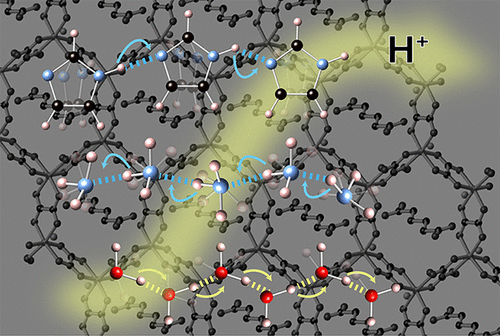当前位置:
X-MOL 学术
›
Chem. Rev.
›
论文详情
Our official English website, www.x-mol.net, welcomes your
feedback! (Note: you will need to create a separate account there.)
Proton Transport in Metal-Organic Frameworks.
Chemical Reviews ( IF 51.4 ) Pub Date : 2020-05-14 , DOI: 10.1021/acs.chemrev.9b00842 Dae-Woon Lim 1 , Hiroshi Kitagawa 2
Chemical Reviews ( IF 51.4 ) Pub Date : 2020-05-14 , DOI: 10.1021/acs.chemrev.9b00842 Dae-Woon Lim 1 , Hiroshi Kitagawa 2
Affiliation

|
Solid-state proton conductors (SSPCs), which are a key component for the safety and efficiency of fuel cells, have received much attention due to their broad application in electrochemical devices. In particular, the development of new materials with high conducting performance and an understanding of the conduction mechanism have become critical issues in this field. Porous metal–organic frameworks (MOFs) or porous coordination polymers (PCPs) have recently emerged and have been extensively studied as a new type of proton conductor due to their crystallinity, designability, and high porosity. These properties are able to adsorb the guest molecules working as conducting media. During the past decade, major advances in proton-conductive MOFs have been achieved with high performance (>10–2 S cm–1), comparable to the conventional material, via various synthetic strategies, and the veiled conduction mechanism has been elucidated through structure analysis and spectroscopy tools such as NMR, X-ray diffraction, and neutron scattering measurement. This Review aims to summarize and provide a comprehensive understanding of proton transport in MOFs. Here, we discuss the fundamental principles and various design strategies and implementations aimed at enhancing proton conductivity with representative examples. We also deal with characterization methods used to investigate proton-conductive MOFs and computational/theoretical studies that aid in understanding the conduction mechanism. Finally, future endeavors are suggested regarding the challenges of research for practical SSPCs.
中文翻译:

金属有机框架中的质子传输。
固态质子导体(SSPC)是燃料电池安全性和效率的关键组成部分,由于其在电化学装置中的广泛应用而备受关注。特别地,具有高导电性能的新材料的开发和对导电机理的理解已经成为该领域中的关键问题。多孔金属-有机骨架(MOF)或多孔配位聚合物(PCP)最近已经出现,由于其结晶性,可设计性和高孔隙率,它们已作为一种新型的质子导体得到了广泛的研究。这些性质能够吸附用作导电介质的客体分子。在过去的十年中,质子传导性MOF取得了重大进展,性能高(> 10 –2 S cm –1),通过各种合成策略可与传统材料相比,并且通过结构分析和光谱学工具(例如NMR,X射线衍射和中子散射测量)阐明了面纱传导机理。这篇综述旨在总结并提供对MOFs中质子传输的全面理解。在这里,我们将讨论具有代表性的示例,旨在提高质子传导性的基本原理以及各种设计策略和实现。我们还将处理用于研究质子传导MOF的表征方法以及有助于理解传导机理的计算/理论研究。最后,提出了有关实际SSPC研究挑战的未来努力。
更新日期:2020-05-14
中文翻译:

金属有机框架中的质子传输。
固态质子导体(SSPC)是燃料电池安全性和效率的关键组成部分,由于其在电化学装置中的广泛应用而备受关注。特别地,具有高导电性能的新材料的开发和对导电机理的理解已经成为该领域中的关键问题。多孔金属-有机骨架(MOF)或多孔配位聚合物(PCP)最近已经出现,由于其结晶性,可设计性和高孔隙率,它们已作为一种新型的质子导体得到了广泛的研究。这些性质能够吸附用作导电介质的客体分子。在过去的十年中,质子传导性MOF取得了重大进展,性能高(> 10 –2 S cm –1),通过各种合成策略可与传统材料相比,并且通过结构分析和光谱学工具(例如NMR,X射线衍射和中子散射测量)阐明了面纱传导机理。这篇综述旨在总结并提供对MOFs中质子传输的全面理解。在这里,我们将讨论具有代表性的示例,旨在提高质子传导性的基本原理以及各种设计策略和实现。我们还将处理用于研究质子传导MOF的表征方法以及有助于理解传导机理的计算/理论研究。最后,提出了有关实际SSPC研究挑战的未来努力。











































 京公网安备 11010802027423号
京公网安备 11010802027423号